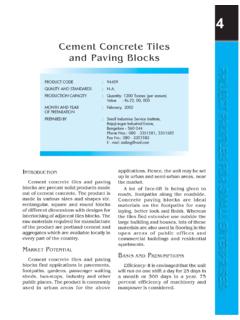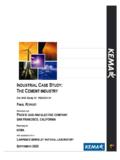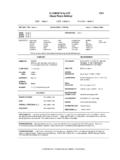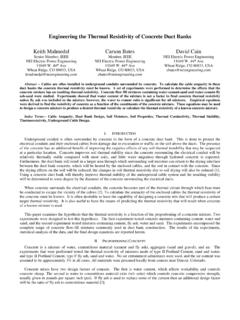Transcription of Constru Cting an iConiC building - lehighwhitecement.com
1 A Whitepaper from the portland cement Association 1 ConstruCting an iC oniC building using white portland CementA Whitepaper from the portland cement Association2 A Whitepaper from the portland cement AssociationConstructing an iConiC building using White portland CementCreating architectural concrete with white portland cement . Concrete dominates the super-tall Joe Nasviknamed for its address, 432 Park Avenue is an upscale condominium project located in the heart of Manhattan, close to Central Park, Rockefeller Center, and Broadway.
2 It is the tallest residential structural concrete building in the western hemisphere at just under 1,400 feet in height, also remarkable because of its small footprint 93 feet square. Exterior faces consist of white concrete columns and horizontal spandrel beams with 10 x 10 foot windows allowing wide range views of Macklowe Properties and CIM Group, New York City, conceived the idea for the $ billion project. Construction for the building began in the fall of 2012 and the building topped out in October of structural concrete work was performed by Roger & Sons (R&S), New York City, a third-generation family business started in 1975.
3 With experience in mid-rise and high-rise concrete construction, including two 500-foot tall buildings and the concrete work for the building 4 project at the World Trade Center, they had the necessary references to bid the Park Avenue the structure The building consists of two struc-tural tubes, one inside the other; the core and the external columns. The two-foot thick core houses the eleva-tors, emergency stairs, and utilities. It provides safe access for occupants and primary load-carrying capacity for the building . The forty-four inch wide exterior columns spaced 15 feet, six inches apart are connected by horizontal spandrel perimeter beams (also 44 inches wide) to form the exterior perforated tube, the depth of these elements decreasing as the building goes up.
4 Ten-inch The exterior faces of the building feature cast-in-place concrete made with white portland cement . The goal was to provide an architectural light colored concrete that shows the richness of concrete as well as a sustainable finish. Photos by Joe NasvikA Whitepaper from the portland cement Association 3thick highly reinforced concrete floors join core to columns and act as a diaphragm, adding stiffness to the tall buildings, engineers must consider wind shear. The strength and shape of the structure are selected and designed to resist wind forces.
5 Two windowless, open floors every twenty stories house mechanical equipment and allow wind to pass through the building to reduce wind shear. In addition a tuned mass damper on the top floor reduces building the normal Grade 60 steel rebar to Grade 97 rebar for vertical reinforcement reduced congestion. The No. 20 (2-1/2 inch diameter) thread bars are delivered to the site pre-cut with a threaded pattern. They are joined by threaded couplers for transferring load. Pete Rodrigues, R&S s manager for the project, says material was more expensive but reduced labor, making it a cost effective for constructionBuilding a project of this magnitude requires much preparation, planning, and value engineering.
6 From the start, R&S enlisted the help of sales engineers from DOKA, and PERI Formwork Systems, to include the latest in forming specifications required a four-day cycle per floor for the first 50 floors and a three-day cycle after that. Each cycle starts with casting the core structure two floor levels above floor construction. The exter-nal columns and perimeter beams follow by one day and are cast with white portland concrete. Casting the floor is the last operation before moving all the formwork up to the next and tracking hor-izontal and vertical geometry for a building like this is challenging because it constantly vibrates due to wind and construction activity.
7 The solution: a fully integrated system from Leica: GPS receivers, triple fre-quency antennas, tilt meters and a one-second robotic total station with software to locate points even during building systemsR&S used DOKA s new SCP Super Climber forming system to build the core. It consists of inside and outside gang forms surrounding the core, along with three completely decked out levels of working and material storage platforms all mov-ing as one unit. A deck carries the concrete placing boom and a three ton, 50-foot telescopic crane boom for lifting reinforcing steel, and sup-ports five floor levels of temporary stair towers for worker access and egress.
8 Forms are stripped from the concrete each day after placement. One button activates hydraulic cyl-inders that lift the entire assembly to the next level to start the next s self-climbing rollback system is also being used on this project. The five-floor level climbing system surrounds the perimeter of the building to provide workers with multiple levels of wide, safe work decks for setting and stripping forms, removing anchors, patching the architectural exterior surfaces, The decision to use #20 grade 97 rebar for vertical reinforcement reduced congestion and was cost productive.
9 With the deformations in a threaded pattern, couplers could be used to join bars together and transfer load. Photos by Joe NasvikWith the core structure on the right and the exterior columns and spandrels on the left of the photo, the 10 thick flat plate floors act as a diaphragm, joining the two vertical elements together. Photos by Joe Nasvik4 A Whitepaper from the portland cement Associationand windows. It also supports columns and perimeter beam forms. These custom-made hinge-forms have stainless steel face sheets (for an as-cast white portland architectural finish), allow stripping of columns and perimeter spandrel beams as a unit, and are rolled backward on the climbing platform so that the entire assembly can be hydraulically moved to the next floor in a single , the most important partThe performance requirements for the concrete were developed by the engineer, requiring.
10 High compressive strength up to 14,000 psi High modulus of elasticity (MOE) msi (millions of psi) Self-Consolidating Concrete (SCC) 30-inch spread requirement. White portland cement concrete with good color consistency Low heat of hydration col-umns and other building ele-ments were considered mass concrete, not to exceed 160 F. A pumpable mix for the entire height of the building Two-hour plus working time Low shrinkage Concrete floors walking-hard within five hours of placement in all weather Mixtures must have the same performance criteria in all weather Sustainable mixtures 70 per-cent portland cement replace-ment with pozzolan Bros.









